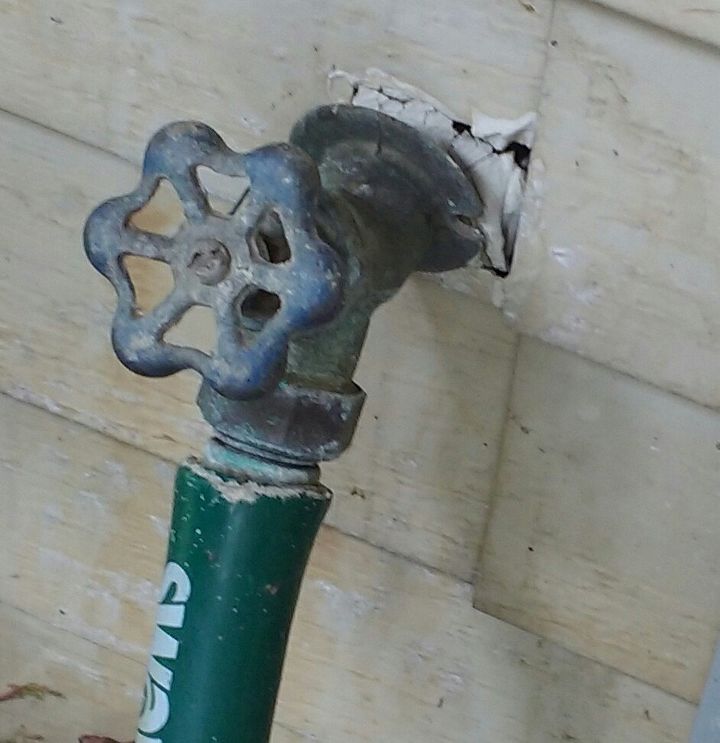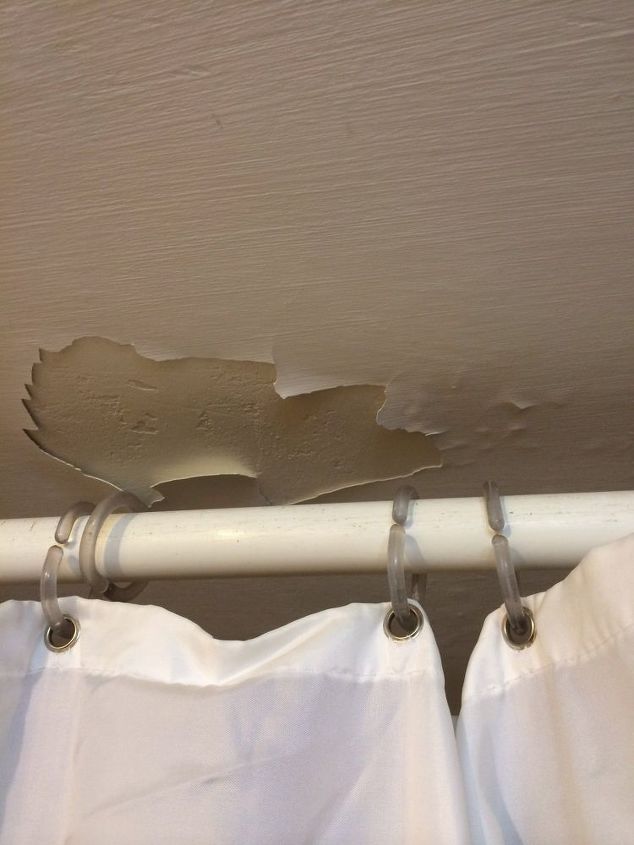I'm bug phobic if they come into my house.

-
You can caulk any small openings and use expandable foam for large openings.
 William
on Jun 18, 2016
Helpful Reply
William
on Jun 18, 2016
Helpful Reply -
-
If you use the expanding foam it needs to be covered/painted or it will deteriorate . Read the instructions and follow them . I learned the hard way.
 Jean Myles
on Jun 18, 2016
Helpful Reply
Jean Myles
on Jun 18, 2016
Helpful Reply -
-
Besides the foam, what could be used? That's all I know that fills large holes.
 Louise
on Jun 18, 2016
Helpful Reply
Louise
on Jun 18, 2016
Helpful Reply -
-
Yes, use the foam. I have kept mice out of my guest house for 2 years now after sealing the openings under the sink with foam. Worked for me.
 Calnbarb
on Jun 19, 2016
Helpful Reply
Calnbarb
on Jun 19, 2016
Helpful Reply -
-
I had a problem in my bathroom, our walls weren't at right angle, so there were too big gap for caulking between bath and walls. I used expanding foam as my base, then trimmed it and on top of it I used silicon. It works well.
 Darius
on Jun 19, 2016
Helpful Reply
Darius
on Jun 19, 2016
Helpful Reply -
-
Absolutely. I tape paper around the area so the foam doesn't go on what it's not supposed to, and then use a knife to trim it. Paint as suggested as it will deteriorate if not.
 Marion Nesbitt
on Jun 19, 2016
Helpful Reply
Marion Nesbitt
on Jun 19, 2016
Helpful Reply -
-
We had the same problem. Bugs aren't all you have to worry about: mice can easily get through the tiniest of holes and they'll chew through the foam. The best thing to do is stuff around the pipe with stainless steel wool - it has to be stainless or it will rust. Then mix up some cement and pack it over to seal it.
 Birdz of a Feather
on Jun 19, 2016
Helpful Reply
Birdz of a Feather
on Jun 19, 2016
Helpful Reply -
-
And the stainless steel wool should NOT be the variety that has soap in it - vermin love eating that! With our 'holes', my husband took the bottoms off large tins with a can opener, then cut them half way up and then nailed them over the pipe holes . But before putting the tin on, he hung a small net bag filled with rat poison in the holes (poison they can eat through the net but not take away for 'later'). Works a treat. Did it for the pipes under the kitchen sink and the bathroom hand basin.
 Ranger
on Jun 19, 2016
Helpful Reply
Ranger
on Jun 19, 2016
Helpful Reply -
-
Make sure there are not alot of bugs trapped in your walls before you close-up their escape routes !
 UpState
on Jun 19, 2016
Helpful Reply
UpState
on Jun 19, 2016
Helpful Reply -
-
I would use silicone caulk, won't be noticeable, plus it will stand up to water.
 Dinah Thomas
on Jun 19, 2016
Helpful Reply
Dinah Thomas
on Jun 19, 2016
Helpful Reply -
-
Definitely clean out what ever was there and fill will masonry caulk found at almost every hardware, the foam type will deteriorate quickly and let small mice and other rodents chew their way into your house,
 Rob5918318
on Jun 19, 2016
Helpful Reply
Rob5918318
on Jun 19, 2016
Helpful Reply -
-
It could be plumbers putty. You need to clean it out from around the spicket then you could use the foam. Make sure you check the expansion foam to see how it expands. There are different types of the foam.
 ReneJackson
on Jun 19, 2016
Helpful Reply
ReneJackson
on Jun 19, 2016
Helpful Reply -
-
Before sealing, use some type of bug spray in the holes. When caulking, use painters tape or masking tape around the edges of the hole. This way, it will look neat and professional. Pull tape off after caulking.
 861650
on Jun 19, 2016
Helpful Reply
861650
on Jun 19, 2016
Helpful Reply -
-
We read that bats can enter the walls of your house through very tiny openings. One house we read about had a colony of bats living in the walls.
 Liz
on Jun 19, 2016
Helpful Reply
Liz
on Jun 19, 2016
Helpful Reply -
-
When I spray bug spray into these holes won't that only kill bugs that might be in the immediate vicinity? Also it seems that if I use caulk it won't completely fill these largish holes. I thought that caulk was only for small areas like in bathrooms around the tub and shower. I think in some ways I'm more confused than when I first started this.
 Louise
on Jun 19, 2016
Helpful Reply
Louise
on Jun 19, 2016
Helpful Reply -
-
Not foam, for reasons mentioned, and these are far too big for caulking. Mortar will shrink. Paint sections of building supply or hardware stores will have 3-M exterior wood filler - or equal. First bug spray, then pack steel wool in, leaving about 1/4 to 1/2 inch. then usea putty knife to fill the hole - two thin coats are best. You can sand and when painted will be barely visible.
 Donpaulin
on Jun 19, 2016
Helpful Reply
Donpaulin
on Jun 19, 2016
Helpful Reply -
-
Purchase a cover plate for an outside (exterior) wall for the size of water line. The cover plate will need to open to be put on and adhered to the stone surface. Hardware in plumbing should be able to help you very easy very cheap
 Penny Mintyala
on Jun 19, 2016
Helpful Reply
Penny Mintyala
on Jun 19, 2016
Helpful Reply -
-
I had this and wasps came into my basement. Our exterminator said it was the biggest nest he'd ever removed. They nested between my ceiling tiles. And, our water line had been coming into the house there for 20 years. Something must have jarred lose---also, little mice can get in there too.
 Veronica Davenport
on Jun 19, 2016
Helpful Reply
Veronica Davenport
on Jun 19, 2016
Helpful Reply -
-
You can absolutely fill the hole in with the foam product called Great Stuff. But first you need to scrape out that dried up brittle caulk and straighten out the faucet. Spray in the foam and let it do its magic, wait for it to dry and then you can trim it up to make it smooth and then paint it to match the house.
 Charly
on Jun 19, 2016
Helpful Reply
Charly
on Jun 19, 2016
Helpful Reply -
-
For the bigger holes, I agree, the foam stuff. For the smaller ones, us caulk.
 Julie B
on Jun 19, 2016
Helpful Reply
Julie B
on Jun 19, 2016
Helpful Reply -
-
I was insulating where the house meets the basement, and I didn't want the itchy king of insulation, so I bought a bag of the "denim" insulation. I used some of that to shove in the hole around my outside faucet, and then I put plastic from a bread bag over the insulation so it wouldn't get wet, and then I used the spray can foam stuff over the remaining gap. So far, after 3 years, I haven't had to redo any of it yet. When you use the spray foam, it will ENLARGE itself, so keep that in mind. Wait for it to totally dry, and then use a serrated knife to cut off any extra of the foam and to make it even. Then paint it unless you like pink or yellow spots on your house. See if you can find some insulation.. even old clothing will work, it will keep the bugs out. (*I'm like you, I hate any bugs in the house)
 Mary
on Jun 19, 2016
Helpful Reply
Mary
on Jun 19, 2016
Helpful Reply -
-
Be very careful with the foam. I sprayed it once around the frame of a door and used too much so when it began to dry it oozed out and was very difficult to remove.
 Kathy
on Jun 19, 2016
Helpful Reply
Kathy
on Jun 19, 2016
Helpful Reply -
-
Great Stuff is a good product. Just remember it foams up puffy. Looks like you could use a all weather caulking. Caulking comes in a variety of colors.
 Amy Pearson
on Jun 19, 2016
Helpful Reply
Amy Pearson
on Jun 19, 2016
Helpful Reply -
-
Steel woo
 Gaylene Dowhanuik
on Jun 19, 2016
Helpful Reply
Gaylene Dowhanuik
on Jun 19, 2016
Helpful Reply -
-
Great Stuff is sand-able, too. I had to cut off the bottoms of my folding closet doors and I filled and sanded them. Works perfectly. Just remember that a little expands a long way!
 Anna
on Jun 20, 2016
Helpful Reply
Anna
on Jun 20, 2016
Helpful Reply -
-
scrape away all the loose material don't use a lot a foam , when hard cut off excess
 Adrian Manning
on Jun 20, 2016
Helpful Reply
Adrian Manning
on Jun 20, 2016
Helpful Reply -
-
I have used fine steel wool to "plug" this kind of a hole...works great as I HATE mice. Mice will not bite into steel wool. Make it tight enough & no bugs can get thru either.
 Dhappel
on Jun 20, 2016
Helpful Reply
Dhappel
on Jun 20, 2016
Helpful Reply -
-
Lots of foam "stuff" to choose from.... bug resistant, water resistant, etc. If you use steel wool, look for some type of disc, or cut a piece of siding to put behind faucet. You can glue it on with Construction Adhesive. It now comes it a tube.
 Judy Collins
on Jun 20, 2016
Helpful Reply
Judy Collins
on Jun 20, 2016
Helpful Reply -
-
to keep bugs out push some steel wool or even a wad of duct tape in to any larger holes then fill with the foam insulation but use a small amount at first because some kinds swell up alot so you will have to cut off the excess..
 Arlis
on Jun 21, 2016
Helpful Reply
Arlis
on Jun 21, 2016
Helpful Reply -
-
use steel wool, it will keep out all kinds of critters, mice too
 Maurita
on Jun 21, 2016
Helpful Reply
Maurita
on Jun 21, 2016
Helpful Reply -
-
I totally agree with what Judy Collins suggested because I wouldn't take any chances of ANY thing coming in through that hole. Don't take any chances. I hate mice also.
 Rita Leaf
on Aug 03, 2016
Helpful Reply
Rita Leaf
on Aug 03, 2016
Helpful Reply -
-
Steel wool
 Gaylene Dowhanuik
on Aug 03, 2016
Helpful Reply
Gaylene Dowhanuik
on Aug 03, 2016
Helpful Reply -
-
Not sure if they have the animals called 'mongoose' down there - but that would also be a pretty big family concern. Steel wool & the foamy stuff. Make sure it doesn't get too puffy...tough to remove.
 UpState
on Aug 03, 2016
Helpful Reply
UpState
on Aug 03, 2016
Helpful Reply -
-
As a REALTOR, I can tell you when I show homes with that ugly foam stuff sticking out of places around a house, it shows the homeowner took the easiest way out of fixing things instead of fixing them right and leaving the home in a pleasing good state of maintenance. I hope you don't use that ugly foam crap. Some of the pics needed a piece of wood or a piece of siding to cover correctly and professionally. The seam down the side of homes in Texas is to let the home move and breathe with the seasons. Sealing the open seam defeats the purpose that apparently the professionals saw fit to do when the home was built. Bug phobic? Spray something into the crack to prevent bugs. The home isn't sealed with the brick. It is sealed and then the brick is laid on the foundation around the home.
 Elwanna
on Aug 03, 2016
Helpful Reply
Elwanna
on Aug 03, 2016
Helpful Reply -
-
Thanks for sharing :)
 Rita Leaf
on Aug 16, 2016
Helpful Reply
Rita Leaf
on Aug 16, 2016
Helpful Reply -
-
Thanks for the info.
 Rita Leaf
on Sep 04, 2016
Helpful Reply
Rita Leaf
on Sep 04, 2016
Helpful Reply -
-
Great question. Looks like a gas line in the picture. Check with your local utility office for their professional recommendation. I too do not like looking at that foamy stuff sticking out of holes, or steel wool either. You could google This Old House and ask Mr. Tom Silva. :)
 Diana Deiley
on Sep 07, 2016
Helpful Reply
Diana Deiley
on Sep 07, 2016
Helpful Reply -
Related Discussions
How to get rid of mice?
We seem to have some unwelcome Mickeys and Minnies in our house. What is the best way to get rid of them?
How to remove popcorn ceiling with asbestos?
I want to remove my popcorn ceiling, but it has asbestos in it. How do I go about this safely?
How to caulk baseboard gaps?
How do I fill gaps at baseboard, should I caulk? If so, does anyone know how to caulk baseboards?
How to fix squeaky hardwood floors?
How do I fix squeaky hardwood floors?
Water damage on bathroom ceiling
I am about to patch up this water damage on a low bathroom ceiling. What can i paint/seal the entire ceiling with to minimize future water damage? the ceiling is very... See more







